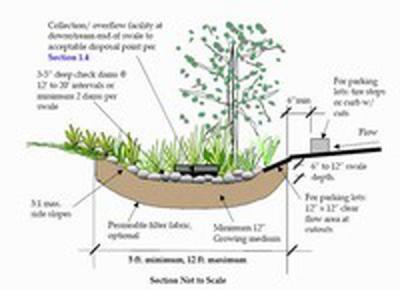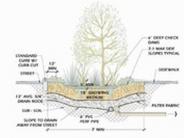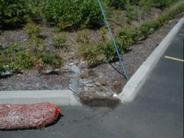Vegetated Swale Specifications
Swales with a gentle slope (less than 4% average) are the most effective at treating stormwater. The maximum slope must be less than 6%. Facility storage depth may range from 2 to 12 inches. A freeboard (6 to 12 inches) may be required if the adjacent area would be damaged by flooding. Maximum side slopes are 3 horizontal to 1 vertical; slopes and depths should be minimized to the extent practical for aesthetic and safety reasons.
Check dams are required every 12 to 20 feet (or a minimum of 2 per swale) to promote ponding, and should be 12 inches in length, the width of the swale, and 3 to 6 inches high. River rock can be used to create an attractive, effective check dam. For privately maintained facilities, the minimum bottom width is 2 feet, with a minimum total facility width of 5 feet. The minimum swale length is 20 feet.
If water will enter the facility as sheet flow from a parking lot, sidewalk or other similar impervious surface, a 12-inch minimum flat area is required adjacent to the impervious surface. Tire stops or curbs with curb cuts should be located 6 inches back from the edge of the swale, and curb cuts must be 12 inches wide, located at a minimum of 10 feet on center. An energy dissipater may be necessary at curb cuts to prevent erosion. Periodic cleaning may be required to ensure that curb cuts do not get blocked with debris.
If water will enter the facility through a pipe or other point source, a flow spreader or energy dissipater, such as river rock, is required at the inlet.
For street Swales, steeper side slopes (maximum of 2:1) and a narrower total width are allowed. Impermeable fabric is required along the street edge to the bottom of the swale, and drainage must be provided away from the street.



